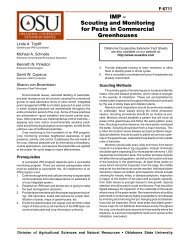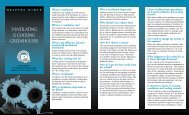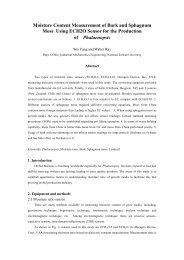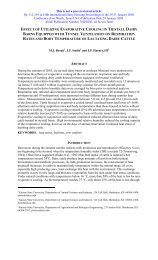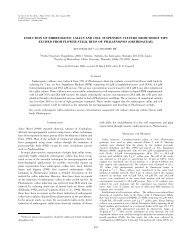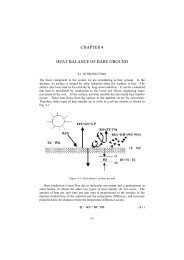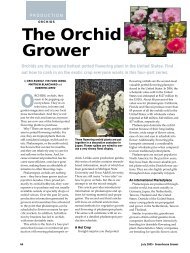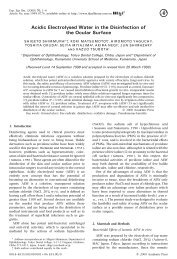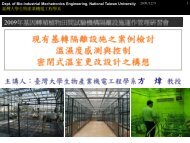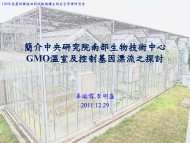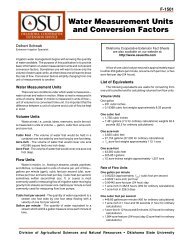Review on thermal energy storage with phase change: materials ...
Review on thermal energy storage with phase change: materials ...
Review on thermal energy storage with phase change: materials ...
- No tags were found...
Create successful ePaper yourself
Turn your PDF publications into a flip-book with our unique Google optimized e-Paper software.
B. Zalba et al. / Applied Thermal Engineering 23 (2003) 251–283 2714.2. C<strong>on</strong>servati<strong>on</strong> and transport of temperature sensitive <strong>materials</strong>When transporting food, in many cases the food temperature must be kept above a certaintemperature or if it is frozen food defrosting must be avoided. The situati<strong>on</strong> is similar whentransporting temperature sensitive medicati<strong>on</strong>s. Both applicati<strong>on</strong>s are suitable to apply PCM,because the PCMs capability to store heat and cold in a range of <strong>on</strong>ly several degrees can be usedvery well. This applicati<strong>on</strong> can already be found in the market <strong>with</strong> many companies commercialisingtransport boxes for sensitive <strong>materials</strong> [54,172,173]. Several companies could be named:va-Q-tec GmbH [174], Rubitherm GmbH [45], Sofrigam [175], TCP RELIABLE [176], PCMThermal Soluti<strong>on</strong>s [177], Bio Trans [54], etc.Electr<strong>on</strong>ic comp<strong>on</strong>ents tend to age and finally fail very fast when their operating temperaturerises bey<strong>on</strong>d a critical limit. The applicati<strong>on</strong> of PCM to restrict the maximum temperature ofelectr<strong>on</strong>ic comp<strong>on</strong>ents seems very promising, especially as they act as passive elements andtherefore do not require any additi<strong>on</strong>al source of <strong>energy</strong> [178–180]. Several applicati<strong>on</strong>s can befound in the market already [172], commercialised by, for example, TEAP [42], Climator [44], andEPS [181].When engines and hydraulic machines are started from low temperatures, <strong>energy</strong> c<strong>on</strong>sumpti<strong>on</strong>and abrasi<strong>on</strong> are high. Therefore, several companies have already investigated and developedlatent heat stores for motor vehicles [182–186]. In this applicati<strong>on</strong>, the heat store is heated up bythe cooling fluid while the engine is running. When the engine is stopped, the heat is stored andcan be used to preheat the engine <strong>on</strong> a new start. Using the heat store it is possible to reach anoptimised working temperature <strong>with</strong>in the engine in a much shorter time than <strong>with</strong>out heat store[187].4.3. Building applicati<strong>on</strong>sThe use of PCMs for themal <strong>storage</strong> in buildings was <strong>on</strong>e of the first applicati<strong>on</strong>s studied,together <strong>with</strong> typical <strong>storage</strong> tanks. The firsts applicati<strong>on</strong> of PCMs described in the literature wastheir use for heating and cooling in buildings, by Telkes in 1975 [12], and Lane in 1986 [3]. The useof building structural comp<strong>on</strong>ents for <strong>thermal</strong> <strong>storage</strong> was pointed out already in 1975 byBarkmann and Wessling [188], and later by other authors [9,89,92].One very important subject in applicati<strong>on</strong>s like the use of PCMs in buildings, is that of safety.An article by Salyer [189] reports <strong>on</strong> reacti<strong>on</strong> to fire and the possible fire-retardant additives(organic halogenous compounds) that improve the resp<strong>on</strong>se to fire of the material. This papercovers an important number of applicati<strong>on</strong>s in the field of heating and cooling, and sets out areview of <strong>materials</strong>, advantages, disadvantages and characteristics of a series of PCM substancesapplicable to <strong>thermal</strong> <strong>storage</strong> in buildings. Of the four possible PCM analysed, those <strong>with</strong> thegreatest advantages were of the paraffin type (hydrocarb<strong>on</strong>s; )60 to 80 °C) whose origin can befrom the polymerisati<strong>on</strong> of ethylene or as a by-product of petroleum. Am<strong>on</strong>g the suppliers citedare Shell, Exx<strong>on</strong>, Gulf, Sun Oil, and Witco. The trade names and prices of various paraffins arealso given.An important disadvantage of light weight buildings is their low <strong>thermal</strong> mass. They tend tohave high temperature fluctuati<strong>on</strong>s, which result in a high heating and cooling demand. The




